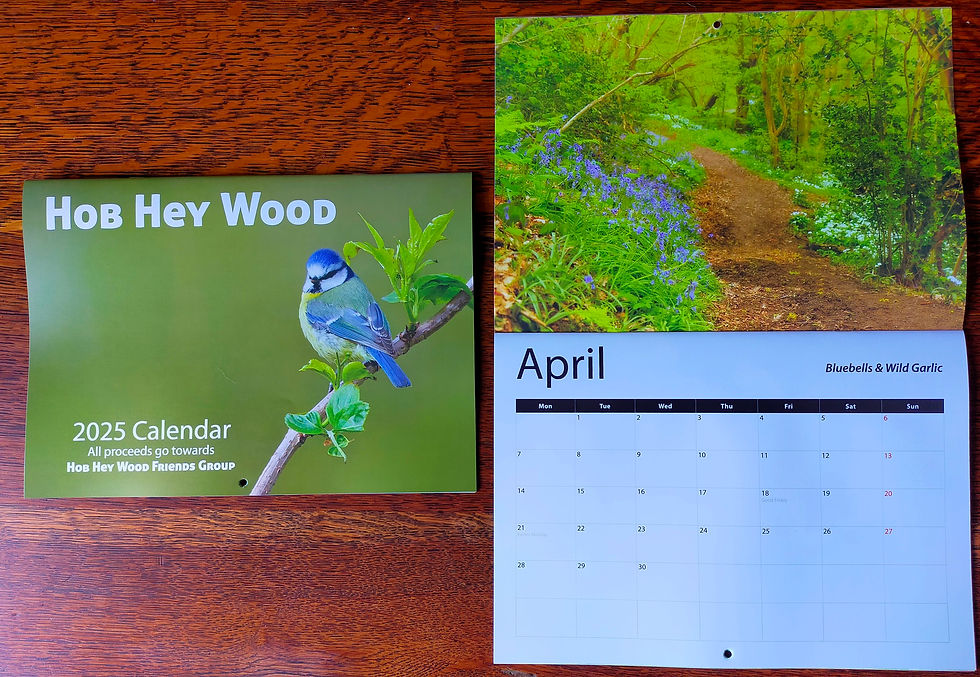Flowers of Hob Hey Wood
- Mark O'Sullivan

- Sep 23, 2018
- 3 min read
Updated: Apr 2, 2020
We are now coming into the peak season for flowers in Hob Hey Wood and it is becoming filled again with gorgeous blooms. This blog entry is a guide to what can be seen in the wood.

Hob Hey Wood is ancient semi-natural woodland so, by definition, is at least 400 years’ old. It has, therefore, had centuries to develop a varied and interesting range of flower species. Some varieties are spectacularly showy, such as the bluebell and wild garlic, others are more retiring (such as the common violet) yet no less beautiful.

Usually the first to appear (in March), lesser celandine is a harbinger of spring, can carpet large areas of the wood, and can look amazing against the dark colours of winter. Its flowers provide a really important source of nectar for bees, early in the year. It was also known as 'pilewort' and actually used to treat piles!

Around the same time appears a little flower with a big name: alternate-leaved golden saxifrage. These flowers are tiny, but subtly beautiful, are quite common but easy to overlook.

The wood anemones then appear. Again, these can produce quite large carpets of spectacularly brilliant white flowers.

A recent discovery (for me) in Hob Hey Wood is the primrose. I found a small clump of these pretty little flowers near the main bridge.

In April, wood sorrel flowers. These are generally found in small clumps, often in slightly raised areas. They are edible and said to have an apple-like taste that is quite refreshing.

The above flowers precede the main event: bluebells and wild garlic. These flower in April and can cover large areas. See the largest patch of bluebells to the south of the main bridge. The north bridge often has a spectacular carpet of wild garlic.

Easy to overlook is the common dog violet. These appear in April and can be seen in small patches on the path to the north bridge.
When the bluebells and ramsons have faded away, there’s still plenty to see.

Wood avens is a common flower that occurs in small groups rather than large mats in the wood. It's thought that the common name 'Herb Bennet' arose from the medieval Latin 'herba benedicta' meaning 'the blessed herb' because the plant was widely used in herbal medicine at this time.

Red campion flowers after the bluebells are past their best, their pink contrasting with most other flowers yellow and white colours. Folklore tells that red campion flowers guard bees’ honey stores, as well as protecting fairies from being discovered.

A flower with an 'enchanting' name: enchanter's nightshade. This flowers in summer and is quite common in the wood. The Latin name Circaea relates to Circe, an enchantress sometimes depicted as the Greek goddess of magic, who was known for her knowledge of herbs.

Herb robert, flowering from May to September has the rather unsettling other name of death-come-quickly which refers to a myth that an evil fairy would visit a household and someone would die.

Yellow pimpernel can be found along the northern path in the wood, close to the north bridge. Where it occurs, it can be present in large mats, its tiny yellow flowers giving a dazzling display.

Three-veined sandwort is really easy to overlook as its flowers are really tiny. I have found two patches in the wood, one near the picnic table.
One plant to be wary of is lords and ladies. This flowers in April and May and produces red berries in autumn. Although these look pretty, they’re very toxic and should be avoided.


Hob Hey Wood is an excellent place to see the flowers shown here. When you visit, see how many you can spot.




Comments